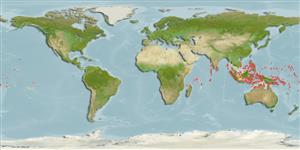Common names from other countries
>
Blenniiformes (Blennies) >
Tripterygiidae (Triplefin blennies) > Tripterygiinae
Etymology: Norfolkia: Named for the Norfolk Island ( In 1953 Henry W. Fowler named this new genus on a Collection of Fishes Made by Dr. Marshall Laird at Norfolk Island) (R.Bajol, pers.comm. 04/2016).; brachylepis: Named for the scales on the pectoral fin base (Latin 'brachium' for upper arm and 'lepis' for a scale of a fish) (R. Bajol, pers.comm. 04/16)..
More on author: Schultz.
Environment: milieu / climate zone / depth range / distribution range
Ecologie
marien rifbewoner; diepte 1 - 25 m (Ref. 90102), usually 2 - 7 m (Ref. 13227). Tropical; 16°N - 15°S
Indo-West Pacific: widespread; from the Red Sea to South Africa; from Sri Lanka, the east and west coast of Australia, Indonesia, southern Japan and east to the Marshall Islands, New Caledonia and Fiji.
Grootte / Gewicht / Leeftijd
Maturity: Lm ? range ? - ? cm
Max length : 7.3 cm TL mannelijk / geslacht onbekend; (Ref. 11441)
Korte beschrijving
Determinatiesleutels | Morfologie | Morfometrie
Dorsale stekels (totaal) : 18 - 19; Dorsale zachte stralen (totaal) : 10 - 11; Anale stekels: 2; Anale zachte stralen: 20 - 21. This species is distinguished by the following characters: D IV + XIV-XV + 10-11 (IV+XV+11); A II, 20-21 (21), spine length half of the rays; pectoral rays 16, dorsalmost 2-3 and ventral most 7 simple, remainder branched once; pelvic rays bound together by membrane for less than one-fourth of length of shorter ray; lateral line pored scales 21-24 (22), terminates between 2nd and 3rd dorsal fins; notched scales and 14-19 (16); total lateral scales 32-35 (34); dentary pores 5-6 + 1 + 5-6; orbital and nasal cirri palmate and about as large as pupil diameter; dorsal fin also with cirri at tips of spines; head 2.9-3.6 (3.3) in SL, eye 3.0-3.9 (3.3), maxilla 2.3-3.0 (2.6) and snout 3.3-4.9 (3.8) in head length (Ref. 88983).
Adults inhabit coral or rock, often under ledges, on clear lagoon and seaward reefs (Ref. 13227). Eggs are hemispherical and covered with numerous sticky threads that anchor them in the algae on the nesting sites (Ref. 240). Larvae are planktonic which occur primarily in shallow, nearshore waters (Ref. 94114).
Levenscyclus en paargedrag
Maturities | Voortplanting | Spawnings | Egg(s) | Fecundities | Larven
Holleman, W. and S.V. Bogorodsky, 2012. A review of the blennioid fish family Tripterygiidae (Perciformes) in the Red Sea, with description of Enneapterygius qirmiz, and reinstatement of Enneapterygius altipinnis Clark, 1980. Zootaxa 3152:36-60. (Ref. 88983)
Status op de Rode Lijst van het IUCN (Ref. 130435)
CITES (Ref. 128078)
Not Evaluated
Gevaar voor de mens
Harmless
Gebruik door de mens
Visserij: van geen belang
Tools
Speciale rapporten
Download XML
Internetbronnen
Estimates based on models
Preferred temperature (Ref.
115969): 27.6 - 29.3, mean 28.7 (based on 1848 cells).
Fylogenetische diversiteitsindex (Ref.
82804): PD
50 = 0.5625 [Uniqueness, from 0.5 = low to 2.0 = high].
Bayesian length-weight: a=0.00562 (0.00258 - 0.01228), b=3.08 (2.89 - 3.27), in cm Total Length, based on LWR estimates for this (Sub)family-body shape (Ref.
93245).
Trofisch niveau (Ref.
69278): 3.2 ±0.4 se; based on size and trophs of closest relatives
Weerstandsvermogen (Ref.
120179): Hoog, minimale populatieverdubbelingstijd minder dan 15 maanden (Preliminary K or Fecundity.).
Fishing Vulnerability (Ref.
59153): Low vulnerability (10 of 100).
